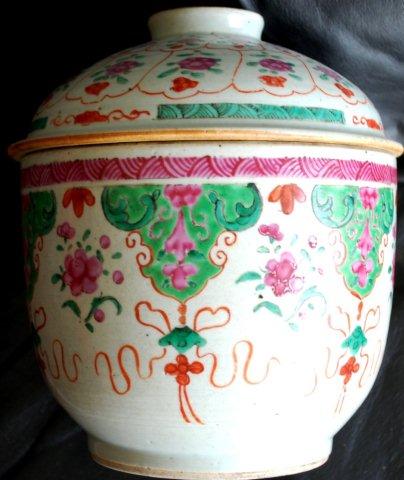 |
|
Omani soapstone vessel 3000-4000 years old
|
The 3000-4000 year old Omani soft stone vessels are discussed in the Journal of Oman Studies series and a few other archaeological publications (e.g. Pott's) but overall the information is not very comprehensive (often vague sketches and descriptions rather than proper photos) The dating of these items also does not seem to be very consistent to a laymen. Soft stone vessels can be made of Steatite (talc) , Soapstone or Chloride. The vessels were exported from Oman to Mesopotamia and the Indus Valley. Some archaeologists describe Oman as "the land of graves", with ancient graves scattered around large parts of the country. Some well known ancient archaeological places are Baht (beehive graves), Maysar (copper mines and processing) , Lizk (fort) , Ras Al Hamra , Bawshar (graves) , Ras Al Junayz, Al Shir Jaylah (towers) and Shisr (the possible Ubar location)
The best source on "more recent" Omani pottery is probably "The craft Heritage of Oman" by Richardson & Dorr in 2003, but by then a lot of knowledge probably had been lost already.
The book Islamic Art in Oman contains a chapter on early Islamic pottery found in Oman by Seth Priestman (British Museum)
No dedicated publication exists on Omani pottery covering the last 4 centuries. Oman is a very large country (comparable in size to Great Britain) Therefore it is logical that there are different pottery styles. E.G some with stronger Iranian influences some with trading influences from East Africa and China. A famous place for pottery in the interior is Bahla. You can still visit the fascinating old Kilns in this town. In places like Qalhat loads of early Chinese pottery sherds can be found, often dating before the 17th century, thereby confirming Oman´s long history of trading with other nations. Qalhat and Sohar were key harbours of the Kingdom of Hormuz run by Persians and Omani Arabs.
In 1672 a Dutch VOC ship visited Muscat. A Mr. Padtbrugge produced a detailed report on the products he observed in the shops and the methods and quality of products being made locally They observed that most pots, plates and cups were made of tinned copper, however they also reported on the skilled potters and unusual methods of glazing pottery. See below for more details)

Ancient Omani Tower Tombs at Jaylah. First discovered by a helicopter pilot
Late 18th century and during the first half of the 19th century a lot of Chinese provincial porcelain was imported to Oman for domestic use (see our Imports to Oman section) this consisted particularly of glazed plates, small bowls and ginger jars. The ginger jars often being used to store honey.




Chinese glazed ginger Jars (Chinese provincial pottery) imported to Oman 150-200 years ago (typically used for storing honey) See Import section of this website.
Between 1885-1915 pottery (with transfer printed decoration) from Belgium and Holland (e.g. Maastricht Regout) was imported to Oman, this is possibly related to the large quantities of guns imported to Oman from Belgium (e.g. so called Muscat Martini Henry's) maybe pottery was used to fill-up spare cargo space or to hide the guns??? Most of these guns were exported again by the Omani to for example Indian and Afghan rebels fighting the British (see e.g. Gun-Running and the North West Frontier by Keppel 1911) By around 1910 the British navy was still searching Omani vessels (sometimes sailing under the French flag) for slaves and guns.

Examples of antique glazed pottery made in Oman, discussed in detail below
In 1672 a Dutch VOC ship visited Muscat and a Mr. Padbrugge visited the Muscat souq. Their report also contains a section on pottery: “They can also turn clay quite well , because the beads of their rosaries (in reality the Arabian playing-string) which the Roman-Catholics call paternosters, all must be turned, and those things are a prestige-object. The potters are very handy in glazing. They do not do this like us by stirring lead melted for a long time with an iron comb, but they drop melted lead in the water, fetch it out again and melt it anew and once again pour it in the water and repeat that. That has to be a very slow work, but it saves the sifting of lead-ashes because those disperse very finely in the water. These ashes are then pounded fine and mixed with sifted charcoal. With this they glaze very handy the loam. This gives red glazing as if it has been burned somewhat harder, and mixed with some smoke-black, black. Some brass mixed through gives a light or heavy green glazing” Translation by Dr. B. Slot in "Oman Holland a short history of the relations between the Sultanate and the Netherlands" The text can also be found in Dutch in the booklet "Nederlanders aan de kusten van Oman" by B.J. Slot published by Museon in 1991 page 13

Traditional Omani kiln photographed in Bahla during the 1980's